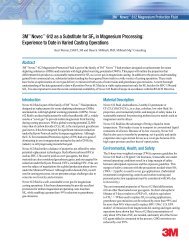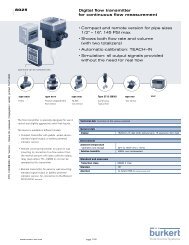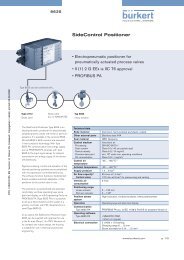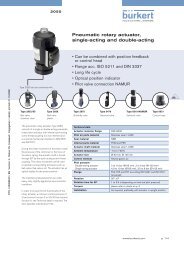Solenoid valves - Bürkert Fluid Control Systems
Solenoid valves - Bürkert Fluid Control Systems
Solenoid valves - Bürkert Fluid Control Systems
Create successful ePaper yourself
Turn your PDF publications into a flip-book with our unique Google optimized e-Paper software.
4. Materials for Bürkert solenoid <strong>valves</strong><br />
The materials for body, seals and actuator<br />
are selected and intermatched to<br />
produce optimum products in regards<br />
to functional reliability/safety, fluid<br />
compatibility, service life and economy.<br />
Basically, the materials listed in the<br />
table below, with the material properties<br />
shown, are available. The available<br />
materials can be taken from the relevant<br />
data sheet for the solenoid valve.<br />
Materials Code<br />
General chemical resistance Permissible temperatures<br />
Coil materials<br />
Neutral media<br />
constant<br />
Neutral media<br />
short-term<br />
Aggressive media<br />
constant<br />
Epoxy resin EP Resistant to virtually all chemicals. -20 °C to<br />
Not resistant to low-molecular organic +150 °C<br />
acids in high concentration and highly<br />
oxidizing substances.<br />
Polyamide PA See Body materials (plastics)<br />
Seal and diaphragm materials<br />
Ethylene-propylene- EPDM (A) Good resistance to ozone and weathering, -30 °C to Dependent<br />
rubber particularly suitable for aggressive +130 °C on the agchemicals.<br />
Unfavorable for oils and<br />
gressiveness<br />
greases.<br />
of the medium<br />
and the<br />
mechanical<br />
load<br />
Fluorinated rubber FPM (F) The chemical properties are the most -10 °C to -10 °C to<br />
(FKM) favorable of all elastomers. +150 °C +200 °C<br />
Nitrite rubber NBR (B) Good resistance to oil and petrol. -10 °C to -10 °C to<br />
Unfavorable for oxidizing media. +90 °C +120 °C<br />
Chloroprene rubber CR (N) The chemical properties are very similar -10 °C to -10 °C to<br />
(neoprene) to those of PVC and lie between those of +100 °C +110 °C<br />
NBR and EPDM.<br />
Perfluorinat. rubber FFKM Similar to PTFE -10 °C to to<br />
FFKM, FFKM (dependent on blend) +260 °C +320 °C<br />
(FFKM only)<br />
Chemraz +230 °C<br />
Polytetrafluor- PTFE (E) See Body material (plastics)<br />
ethylene<br />
Steel 1.4112 -20 °C to -20 °C to<br />
+450 °C +150 °C<br />
38/39








